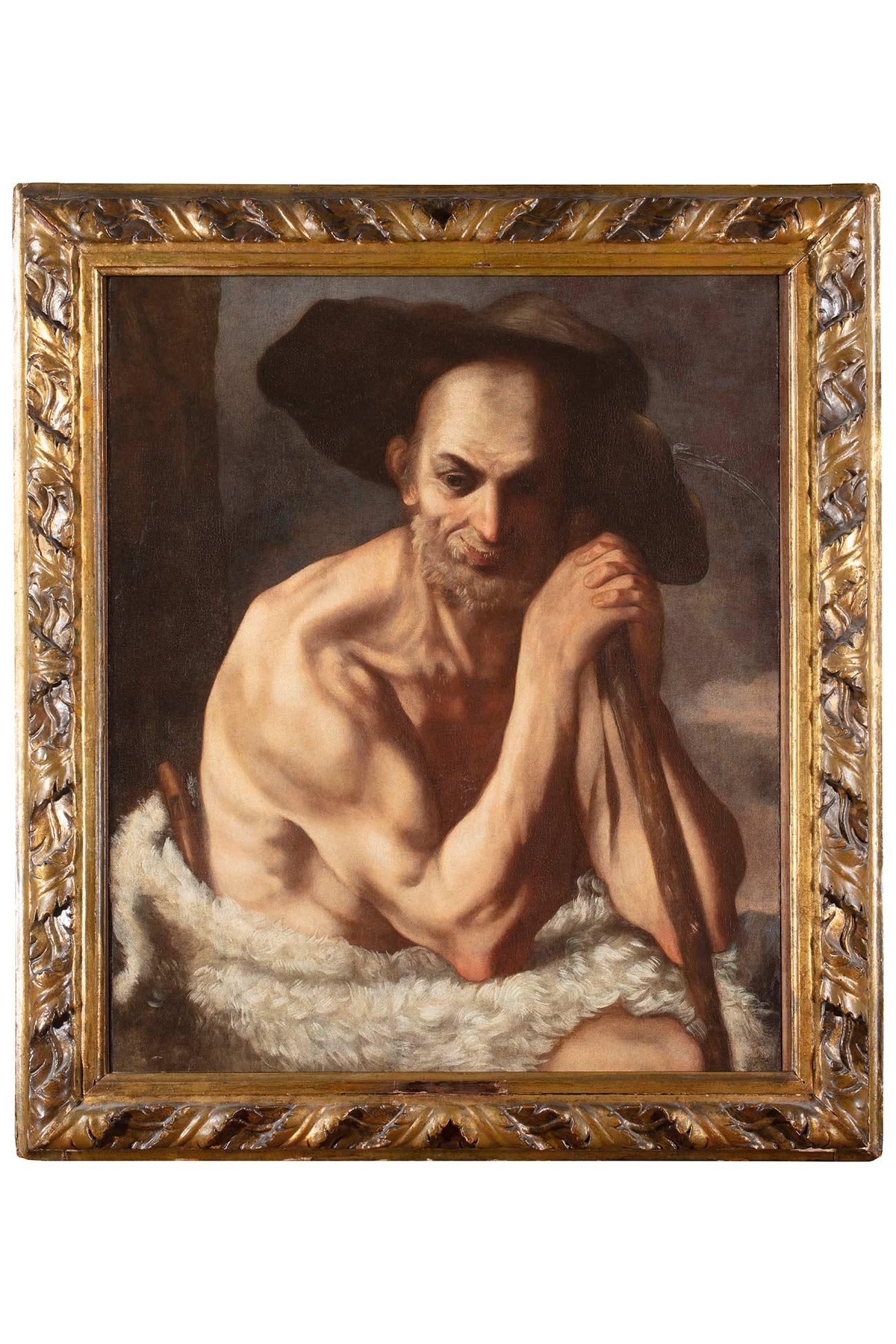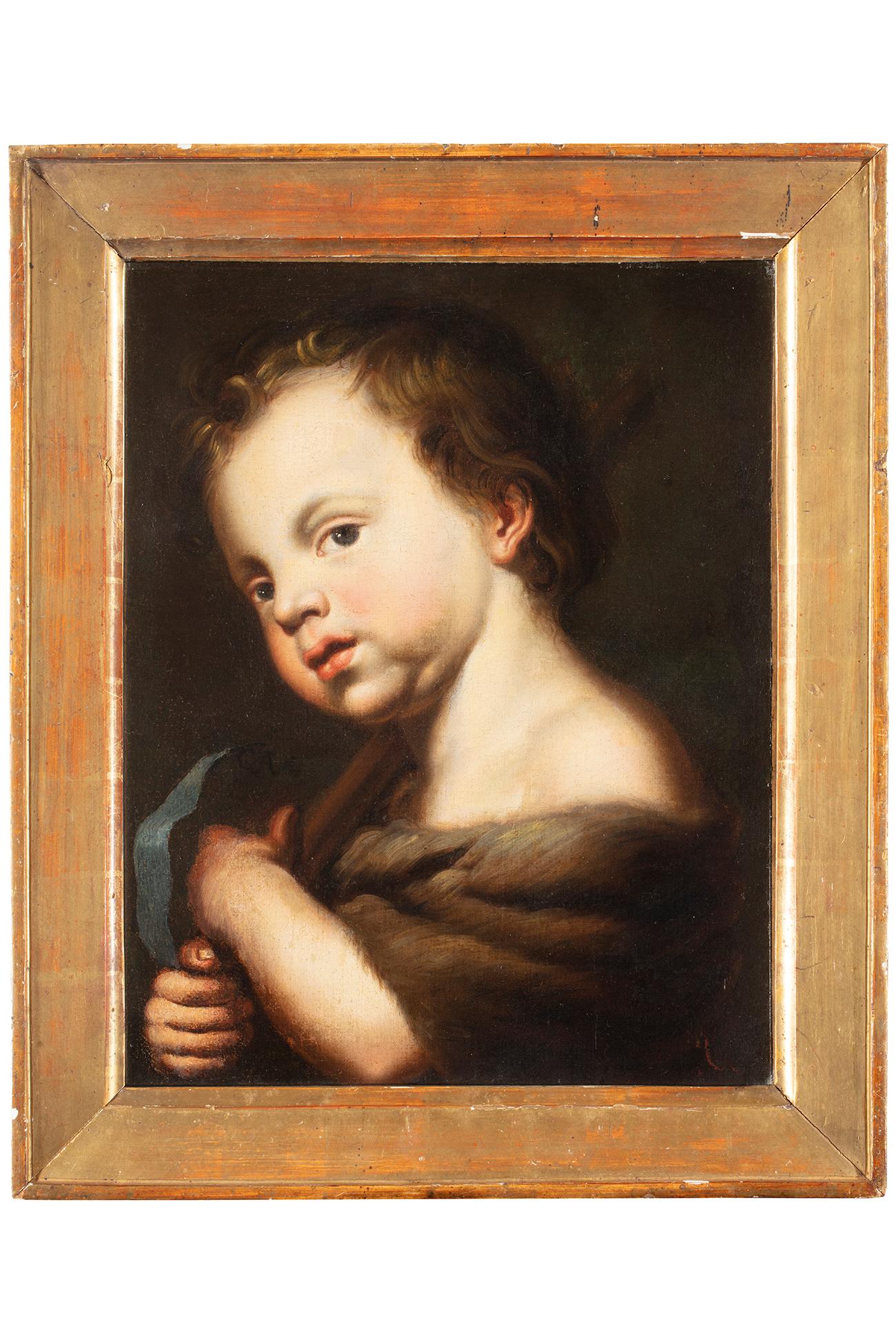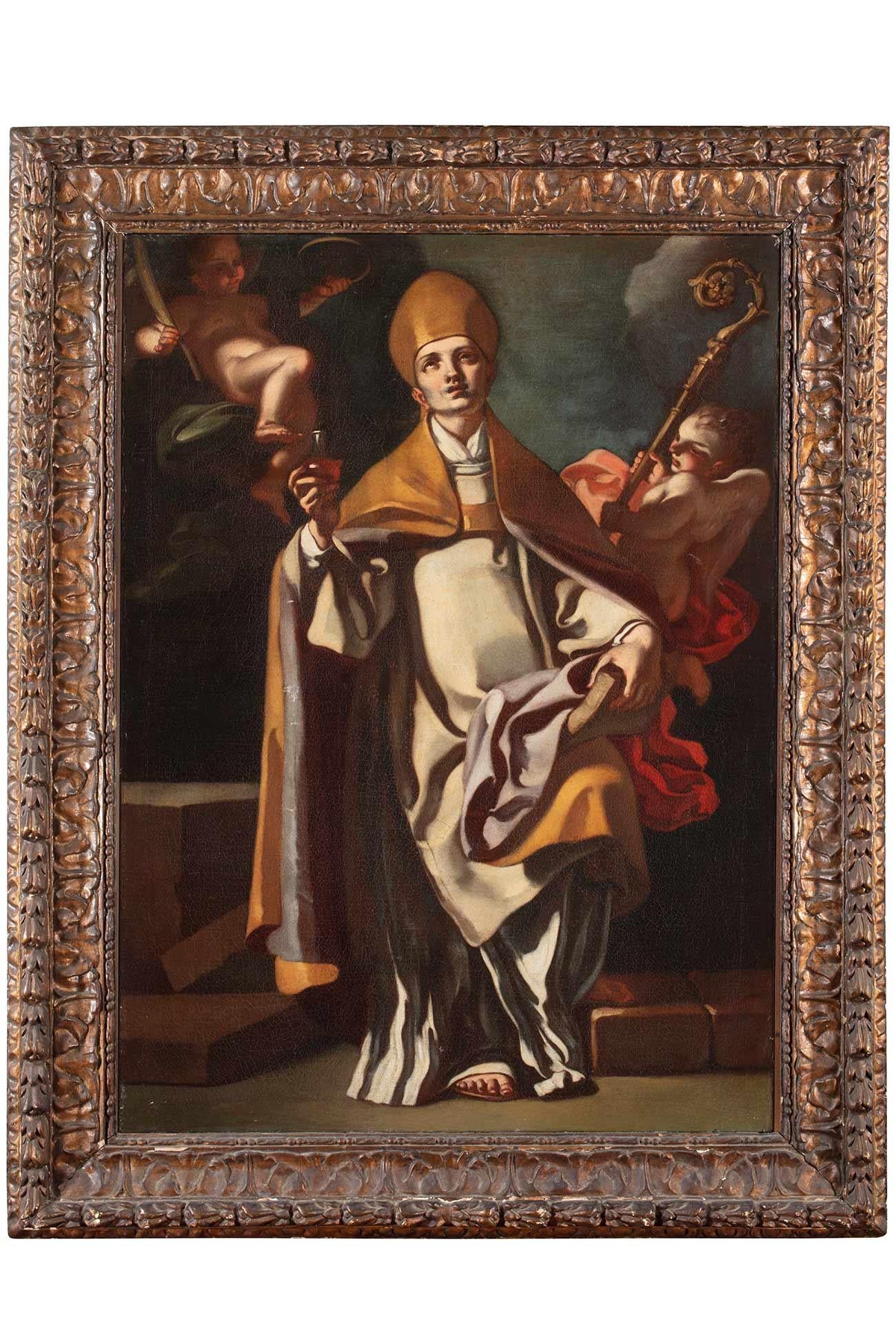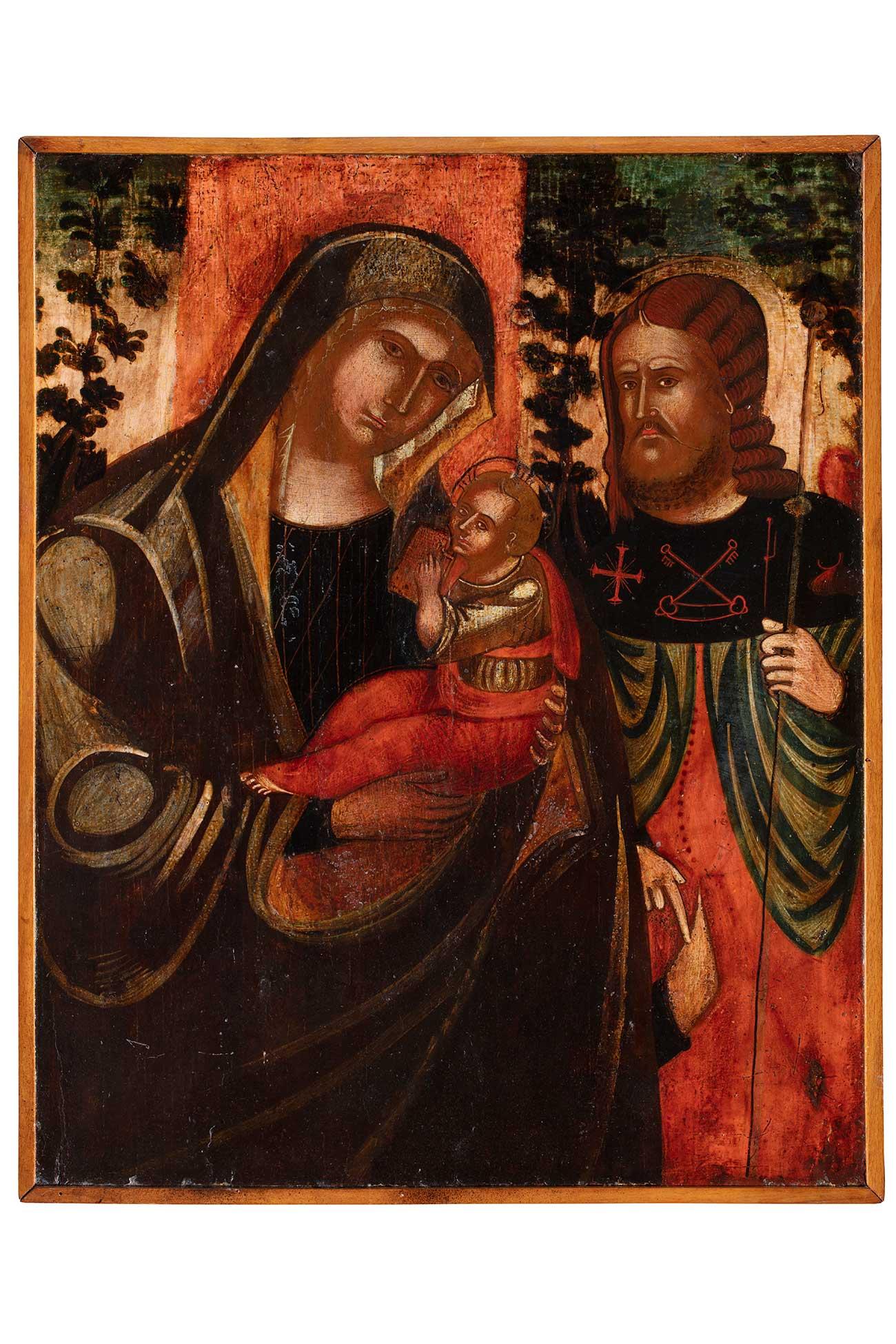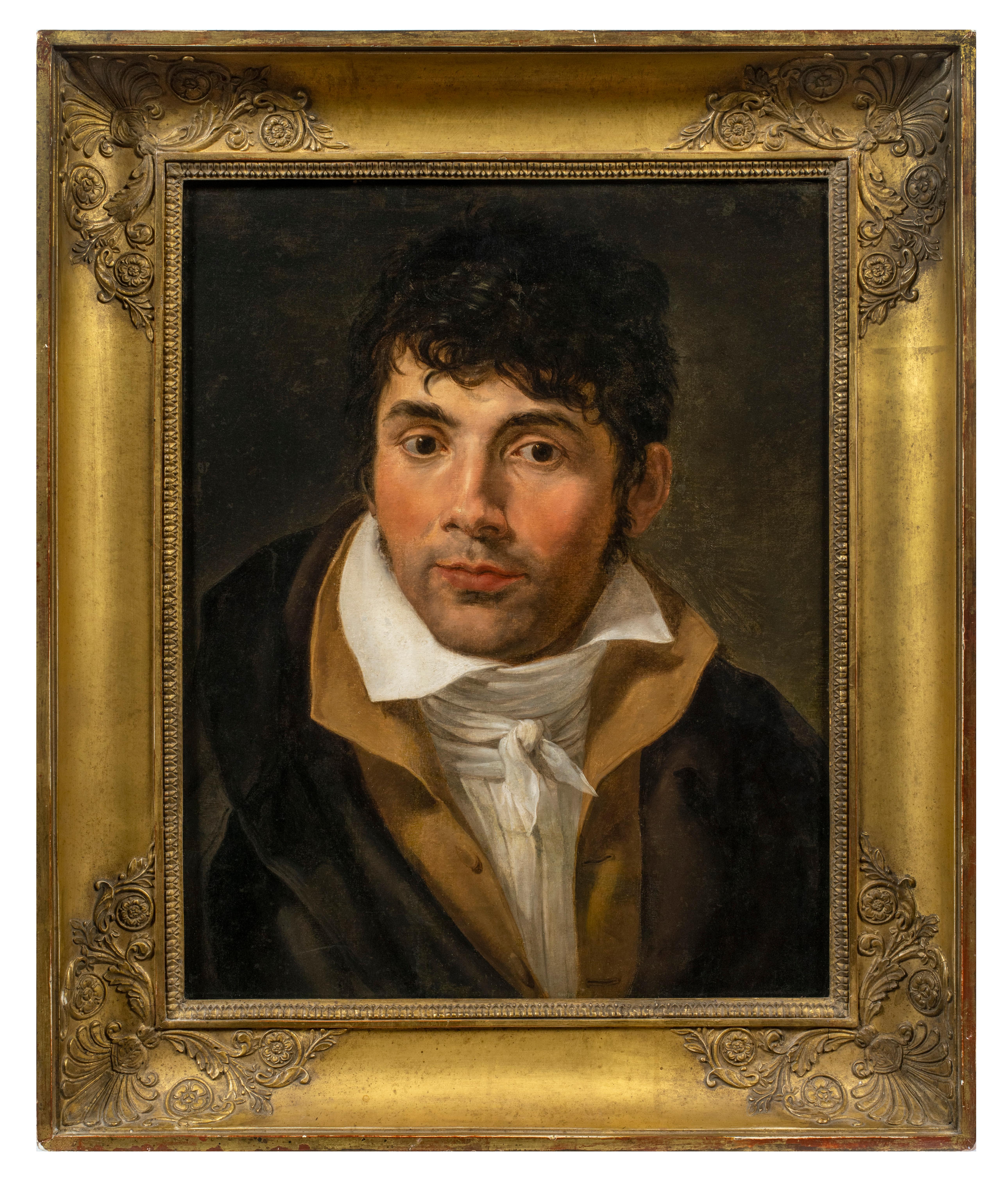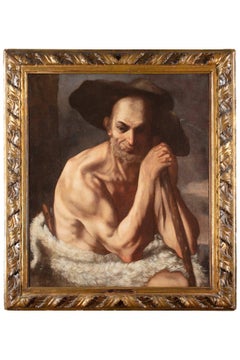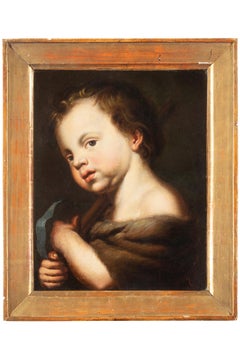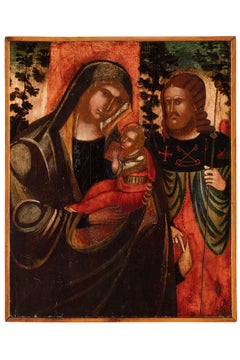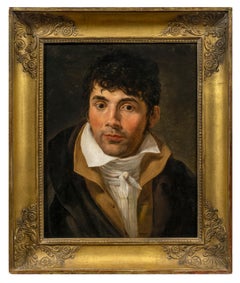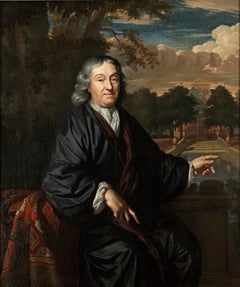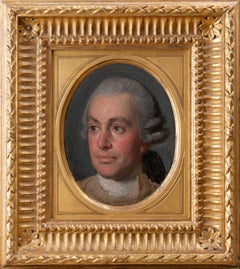Items Similar to 16th Century By Circle of Giovan Battista Moroni Portrait of Woman Oil on Canvas
Want more images or videos?
Request additional images or videos from the seller
1 of 8
16th Century By Circle of Giovan Battista Moroni Portrait of Woman Oil on CanvasEarly 16th Century
Early 16th Century
About the Item
Giovan Battista Moroni (circle of) (Albino, Italy, 1520 – 1580 ca.)
Title: Portrait of a woman
Medium: Oil on canvas
Dimensions: without frame 46 x 40 cm - with frame 55.5 x 50.5 cm
Antique shaped and gilded wooden cassetta frame.
Publications: unpublished.
The present portrait shows an adult woman, no longer young, as can be seen from her slightly blistered cheeks, but not elderly either. The suspicious and veiledly inquisitive gaze is well matched by the elegance of her extremely fashionable black clothes, from which the white ruff emerges luminously. From a stylistic point of view, the work can be assigned to the circle of Giovan Battista Moroni, a famous portrait painter of the 16th century. Moreover, this portrait is similar to Moroni's mature production dedicated to portraits of people belonging to the Bergamo bourgeoisie. The work is a workshop production reproducing the face of "The old lady in black”, a work by Moroni kept in Bergamo at Palazzo Moroni.
- Creation Year:Early 16th Century
- Dimensions:Height: 18.12 in (46 cm)Width: 15.75 in (40 cm)Depth: 1.97 in (5 cm)
- More Editions & Sizes:55,5 x 50,5 cm with framePrice: $12,803
- Medium:
- Movement & Style:
- Circle Of:Giovan Battista Moroni (1520 - 1580, Italian)
- Period:
- Condition:
- Gallery Location:Milano, IT
- Reference Number:1stDibs: LU170129946652
About the Seller
5.0
Vetted Professional Seller
Every seller passes strict standards for authenticity and reliability
Established in 1964
1stDibs seller since 2021
Typical response time: 4 hours
- ShippingRetrieving quote...Shipping from: Milano, Italy
- Return Policy
Authenticity Guarantee
In the unlikely event there’s an issue with an item’s authenticity, contact us within 1 year for a full refund. DetailsMoney-Back Guarantee
If your item is not as described, is damaged in transit, or does not arrive, contact us within 7 days for a full refund. Details24-Hour Cancellation
You have a 24-hour grace period in which to reconsider your purchase, with no questions asked.Vetted Professional Sellers
Our world-class sellers must adhere to strict standards for service and quality, maintaining the integrity of our listings.Price-Match Guarantee
If you find that a seller listed the same item for a lower price elsewhere, we’ll match it.Trusted Global Delivery
Our best-in-class carrier network provides specialized shipping options worldwide, including custom delivery.More From This Seller
View All17th Century by Cristoforo Serra Portrait of a Shepherd Oil on Canvas
Located in Milano, Lombardia
Cristoforo Serra (Cesena, Italy, 1600 - 1689)
Title: Portrait of a Shepherd
Medium: Oil on canvas
Dimensions: without frame 92 x 75 cm - with frame 106.5 x 94.5 cm
Antique gilt-wood...
Category
Early 17th Century Old Masters Portrait Paintings
Materials
Canvas, Cotton Canvas, Oil
17th Century by Pedro Nunez Portrait of a Child Oil on Canvas
Located in Milano, Lombardia
Pedro Nuñez de Villavicendio (Seville, Spain, 1644 - 1700)
Title: Portrait of a child
Medium: Oil on canvas
Dimensions: without frame 41.5 x 33.5 cm - with frame 52 x 43.5 cm
19th century shaped and gilded wooden frame
Expertise by Didier Bodart, art historian
A Seville painter of noble origins, Pedro Nuñez de Villavicendio (1644-1700), the author of this pretty child portrait, was a Knight of the Order of St John of Jerusalem. He was a pupil of Murillo and, as a Knight of the Order of Malta, worked with Mattia Preti...
Category
Late 17th Century Old Masters Portrait Paintings
Materials
Canvas, Cotton Canvas, Oil
18th Century by Evangelista Schiano Saint Gennaro Oil on Canvas
Located in Milano, Lombardia
Evangelista Schiano (attr.) (active in the 18th century)
Title: Saint Gennaro
Medium: Oil on canvas
Dimensions: without frame 102 x 74 cm - with frame 126.5 x 100 cm
19th century car...
Category
Mid-18th Century Old Masters Portrait Paintings
Materials
Canvas, Cotton Canvas, Oil
15th Century by Circle of Nicolò Zafuri Madonna with Child Oil on Canvas
Located in Milano, Lombardia
Nicolò Zafuri (circle of) (documented in Candia between 1487 and 1500, died before 10 July 1501)
Title: Madonna with Child
Medium: Oil on panel
Dimensions: without frame 49 x 40 cm
...
Category
15th Century and Earlier Old Masters Portrait Paintings
Materials
Cotton, Cotton Canvas, Oil
18th Century by Pietro Bardellino Mary Magdalene Painting Oil on Canvas
By Pietro Bardellino
Located in Milano, Lombardia
Pietro Bardellino (Naples, Italy, 1731 – 1806)
Title: Mary Magdalene
Medium: Oil on canvas
Dimensions: without frame 75 x 60 cm – with frame 97 x 82 cm
Antique shaped and carved wood...
Category
Mid-18th Century Old Masters Portrait Paintings
Materials
Canvas, Oil
17th century By Neapolitan Maestro San Vincenzo Ferreri Oil on canvas
Located in Milano, Lombardia
17th Century Neapolitan Maestro
Title: San Vincenzo Ferreri
Medium: Oil on canvas
Dimensions: without frame 63 x 48.5 cm - with frame 77 x 63.5 cm
Original shaped, carved, sculpted a...
Category
17th Century Old Masters Portrait Paintings
Materials
Canvas, Oil
You May Also Like
Italian 18th Century Oval Religious Oil on Canvas Painting with Saint Dominic
By Francesco de Mura
Located in Firenze, IT
This beautiful Italian 18th Century old masters oil painting on oval canvas with giltwood frame is attributed to Solimena and features a religious scene.
In this splendid oval-shaped painting are depicted Saint Dominic...
Category
18th Century Old Masters Figurative Paintings
Materials
Canvas, Oil
Portrait of a Gentleman
Located in New York, NY
Circle of Jacques-Louis David
(French, 18th Century)
Provenance:
Private Collection, Buenos Aires
Exhibited:
“Art of Collecting,” Flint Institute of Art, Flint, Michigan, 23 November 2018 – 6 January 2019.
This vibrant portrait of young man was traditionally considered a work by Jacques-Louis David, whose style it recalls, but to whom it cannot be convincingly attributed. Rather, it would appear to be by a painter in his immediate following—an artist likely working in France in the first decade of the nineteenth century. Several names have been proposed as the portrait’s author: François Gérard, Louis Hersent, Anne-Louis Girodet (Fig. 1), Theodore Gericault, and Jean-Baptiste Wicar, among others. Some have thought the artist Italian, and have proposed Andrea Appiani, Gaspare Landi...
Category
18th Century Old Masters Paintings
Materials
Canvas, Oil
$45,000
Male and female portrait, both in silk kimono, possibly textile dealers
By Christoffel Lubieniecki
Located in Amsterdam, NL
CHRISTOFFEL LUBIENIECKI (1659-1729)
Pair of portraits of a gentleman and a lady, both in silk kimono, before a country house (circa 1680)
Indistinctly signed “C.......” on a box under the man’s left hand
Oil on canvas, 79.5 x 67 cm each
Both sitters are portrayed wearing a silk “Japanese” coat. During the second half of the seventeenth the Japanese silk coat, an adapted Japanese kimono, became a real vogue in the Dutch elite. The exclusive Dutch trade contacts with Japan can explain the popularity of the kimono-style silk coats in the Netherlands. Everybody who could afford one, dressed in such a fashionable and comfortable coat and, like the present sitters, some proud owners had themselves portrayed in a “Japanese” coat often together with an oriental carpet to underline their standing and international connections. These portraits are the work of the Polish-born portraitist Christoffel Lubieniecki (also known as Lubienitski, Lubinitski or Lubiniecki)
Lubieniecki was first trained in Hamburg under Julian Stuhr and after 1675 in Amsterdam under Adriaen Backer and Gerard de Lairesse. He specialized in landscapes, generally of an Italianate character, and in portraits. The loving execution of these contented burghers, enjoying the garden vistas of their country house, places him alongside Amsterdam portraitists such as Constantijn Netscher and Michiel van Musscher...
Category
1680s Old Masters Portrait Paintings
Materials
Canvas, Oil
18th century portrait of the painter Nathaniel Dance
Located in London, GB
Collections:
Robert Gallon (1845-1925);
Private Collection, UK.
Oil on canvas laid down on panel
Framed dimensions: 11.5 x 10 inches
This highly engaging, previously unpublished portrait by Johan...
Category
18th Century Old Masters Portrait Paintings
Materials
Canvas, Oil, Wood Panel
19th century portrait painted in St Petersburg in 1819
Located in London, GB
Signed, inscribed and dated, lower right:
'Geo Dawe RA St Petersburgh 1819', also signed
with initials, lower centre: 'G D RA'; and signed and inscribed verso:
'Geo Dawe RA Pinxit 1819 St Petersburgh';
Also inscribed on the stretcher by Cornelius Varley with varnishing instructions.
Collections:
Private collection, UK, 2010
Literature:
Galina Andreeva Geniuses of War, Weal and Beauty: George Dawe...
Category
19th Century Old Masters Portrait Paintings
Materials
Oil, Canvas
Two royal portraits (the Duc d'Angoulême and the Duc de Berry) by H.P. Danloux
Located in PARIS, FR
These two royal portraits are a major historical testimony to the stay of the Comte d'Artois (the future Charles X) and his family in Edinburgh in 1796-1797. Given by the sitters to Lord Adam Gordon, the Governor of Edinburgh, and kept by family descent to this day, these two portraits provide us with a vivid and spontaneous image of the Duc d’Angoulême and his brother the Duc de Berry. Danloux, who had emigrated to London a few years before, demonstrate his full assimilation of the art of British portrait painters in the brilliant execution of these portraits.
1. Henri-Pierre Danloux, a portraitist in the revolutionary turmoil
Born in Paris in 1753, Henri-Pierre Danloux was first a pupil of the painter Nicolas-Bernard Lépicié (1735 - 1784) and then, in 1773, of Joseph-Marie Vien (1716 - 1809), whom he followed to Rome when, at the end of 1775, Vien became Director of the Académie de France. In Rome he became friends with the painter Jacques-Louis David (1748 - 1825).
Returning to France around 1782, he settled in Lyon for a few years before returning to Paris in 1785. One of his first portraits was commissioned by the Baroness d'Etigny, the widow of the former Intendant of the Provinces of Gascony, Bearn and Navarre Antoine Mégret d'Etigny (1719 – 1767). He then became close to his two sons, Mégret de Sérilly and Mégret d'Etigny, who in turn became his patrons. In 1787, this close relationship with the d'Etigny family was further strengthened by his marriage to Antoinette de Saint-Redan, a relative of Madame d'Etigny. After his marriage, he left for Rome and did not return to France until 1789. It was during the winter of 1790-1791 that he painted one of his masterpieces, the portrait of Baron de Besenval. Set in a twilight atmosphere, this portrait of an aristocrat who knows that his death is imminent symbolizes the disappearance of an erudite and refined society which would be swept away by the French Revolution.
The Jacobin excesses led Danloux to emigrate to England in 1792; many members of his family-in-law who remained in France were guillotined on 10 May 1794. Danloux enjoyed great success as a portrait painter in England before returning to France in 1801.
During his stay in England, Danloux was deeply under the influence of English portraitists: his colors became warmer (as shown by the portrait of the Duc d'Angoulême that we are presenting), and his execution broader.
2. Description of the two portraits and biographical details of the sitters
The Duc d'Angoulême (1775-1844) was the eldest son of the Comte d'Artois, the younger brother of King Louis XVI (the future King Charles X), and his wife Marie-Thérèse of Savoie. He is shown here, in the freshness of his youth, wearing the uniform of colonel-general of the "Angoulême-Dragons" regiment.
He is wearing the blue cordon of the Order of the Holy Spirit, which was awarded to him in 1787, and two decorations: the Cross of Saint-Louis and the Maltese Cross, as he was also Grand Prior of the Order of Malta.
Born on 16 August 1775 in Versailles, Louis-Antoine d'Artois followed his parents into emigration on 16 July 1789. In 1792, he joined the émigrés’ army led by the Prince de Condé. After his stay in Edinburgh (which will be further discussed), he went to the court of the future King Louis XVIII, who was in exile at the time, and in 1799 married his first cousin Marie-Thérèse Charlotte of France, the daughter of Louis XVI and the sole survivor of the royal family. The couple had no descendants. He became Dauphin of France in 1824, upon the accession to the throne of his father but played only a minor political role, preferring his military position as Grand Admiral. Enlisted in Spain on the side of Ferdinand VII, he returned home crowned with glory after his victory at Trocadero in 1823.
He reigned for a very short time at the abdication of Charles X in 1830, before relinquishing his rights in favor of his nephew Henri d'Artois, the Duc de Bordeaux. He then followed his father into exile and died on 3 June 1844 in Gorizia (now in Italy).
His younger brother, the Duc de Berry, is shown in the uniform of the noble cavalry of the émigrés’ Army. He is wearing the blue cordon of the Order of the Holy Spirit, awarded to him in May 1789, and the Cross of Saint-Louis (partly hidden by his blue cordon).
Born on 24 January 1778 in Versailles, Charles-Ferdinand d'Artois also followed his parents into emigration and joined the émigrés’ army in 1792. After his stay in Edinburgh, he remained in Great Britain, where he had an affair with Amy Brown...
Category
1790s Old Masters Portrait Paintings
Materials
Canvas, Oil, Wood Panel
Recently Viewed
View AllMore Ways To Browse
Antique Portraits Of Black People
Italian Cassetta
Happy Fish
Hiroshige Woodblock Print
Incredibles Vintage Poster
J D Challenger
Keith Haring Untitled
Large Bronze Sculpture Native
Large Ice Box
Museum Quality Bed
Orbit Sculpture
Phillip Press
Phoenix Art Glass
Pop Shop 1
Radio Poster
Religious Organization
Resin Face Sculpture
Sebastiao Salgado Gold
